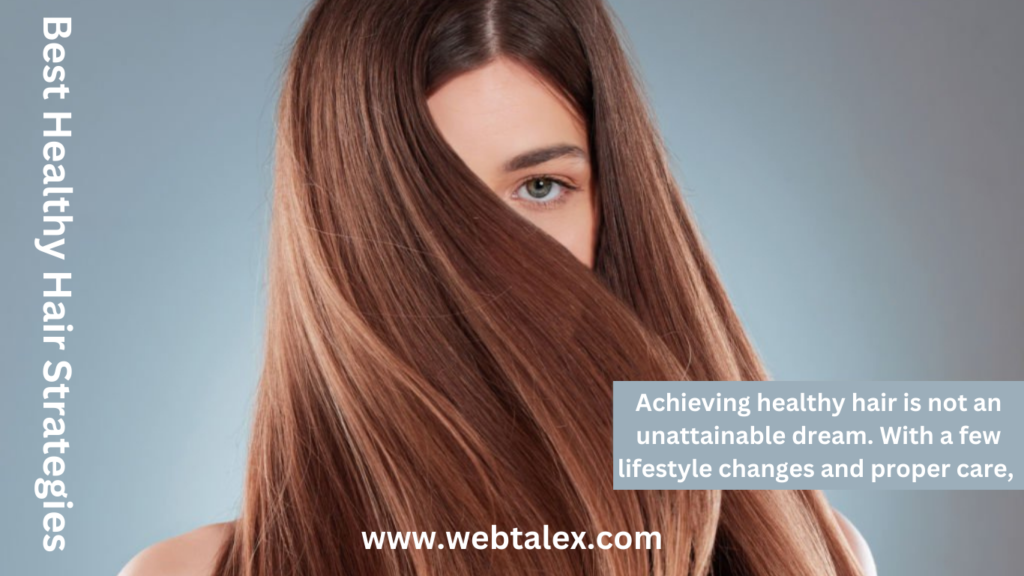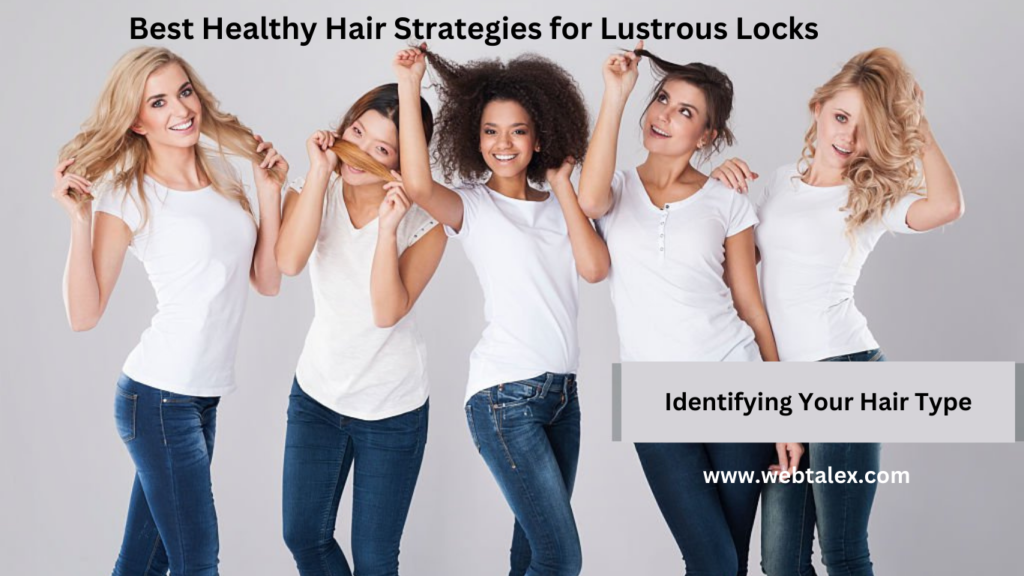Healthy Hair Essentials: Master the secrets to vibrant locks with our concise guide. Embrace expert tips for a lifetime of radiant, strong hair.

How to get long and healthy hair?
- Scalp Health Focus: For healthy hair, pay attention to your scalp’s fitness. Use gentle exfoliating treatments or scrubs once in a while to remove lifeless skin cells and product buildup, making sure the surroundings are wholesome for hair growth.
- Incorporate Natural Oils: Routinely rub your scalp with normal oils like castor oil, which is plentiful in Vitamin E and fundamental unsaturated fats that advance hair development. Other helpful oils incorporate argan, coconut, and jojoba oils.
- Silk Pillowcases: Change to silk or glossy silk pillowcases. Dissimilar to cotton, silk causes less contact and prevents hair tangling and breakage during rest.
- Cold Water Rinse: After washing and conditioning, give your hair a final rinse with bloodless water. This facilitates nearing the cuticles, making your hair smoother and less susceptible to harm.
- Proper Brushing Technique: Use a broom with natural bristles and be gentle. Start from the ends and steadily work your way up to the roots to save your breakage.
- Avoid Over-Washing: Washing your hair too often can strip it of its herbal oils. Depending on your hair type, restricting washes to two or three times per week can help preserve its herbal oil balance.
- Hair Masks: Two times per week, treat your hair with a supporting hair veil. Search for a veil rich in proteins and amino acids, which can be the structural blocks of hair.
- Monitor Water Quality: Hard water can leave mineral deposits on your hair, making it more susceptible to damage. Consider installing a filter in your bath or using a chelating shampoo from time to time.
- Mind Your Medications: Be aware that certain medicines can impact hair health and growth. If you notice adjustments in your hair while on medicine, discuss with your healthcare provider.
- Consult a Trichologist: If you are going through persistent issues with hair growth or healthy hair, do not forget to consult a trichologist. They specialize in the technology of the hair and scalp and can offer tailor-made recommendations and treatment options.
These hints are geared toward a holistic approach to hair care, addressing not simply the hair itself but the environment in which it grows. Incorporating these practices into your hair care routine can result in more longer, healthy hair over the years.
What to eat for healthy hair
| Nutrient/Element | Benefits for Healthy Hair | Unique Food Sources |
|---|---|---|
| Silica | Strengthens hair and prevents thinning. Often overshadowed by more common nutrients, it is similarly essential for hair shape and resilience. | Bamboo shoots, cucumbers (with pores and skin), and excessive-fiber-complete grains like oatmeal. |
| Copper | Plays a function in melanin production, which gives hair its color, doubtlessly delaying graying. | Shiitake mushrooms, sesame seeds, and cashews are best for healthy hair. |
| Gamma-Linolenic Acid (GLA) | An omega-6 fatty acid that promotes healthy hair growth by nourishing the scalp. | Spirulina, evening primrose oil, and borage oil. |
| Sulfur | Known as the ‘beauty mineral’, sulfur is crucial for the production of collagen and keratin, which are essential for healthy hair. | Garlic, onions, and cruciferous vegetables like kale and broccoli. |
| Catechins | Antioxidants that can help reduce dihydrotestosterone (DHT), which is responsible for hair loss. | Green tea, white tea, and apples. |
| Lycopene | An antioxidant that enables in preservation of the fitness of hair follicles and can guard against UV damage. | Tomatoes, watermelon, and pink grapefruit. |
| Anthocyanins | Promotes hair growth by improving scalp circulation and protecting the hair against environmental damage. | Berries, in particular blueberries, cherries, and blackcurrants |
| Choline | Helps with the regeneration of hair follicle cells, contributing to a more potent hair increase. | Cauliflower, eggs (especially the yolk), and tofu. |
| Phytoestrogens | Can make contributions to hair health via balancing hormone degrees, especially in postmenopausal girls. | Flaxseeds, soybeans, and lentils. |
| Inositol | Often grouped with B-nutrients, this nutrient can help prevent hair loss by strengthening hair follicles. | Citrus end result (except for lemons), complete grains, and beans. |
Choose the Right Shampoo: The Foundation of Healthy Hair
- Identify Hair Type: Recognize whether or not your hair is oily, dry, or ordinary to determine your specific wishes.
- Choose a Suitable Shampoo: Select a shampoo formulated for your hair type to promote healthy hair.
- Read labels carefully: Ensure the chosen product matches your hair’s traits and situations.
- Avoid Mismatched Products: Using a mistaken shampoo can result in immoderate dryness or oiliness.
- Lay a Healthy Foundation: Proper shampoo selection is prime to retaining the overall health and look of your hair.
Identifying Your Hair Type

Before you choose a shampoo, it’s essential to understand your hair type. Is your hair oily, dry, or somewhere in between? Different hair types require different formulations.
- For oily hair, look for shampoos with “clarifying” or “balancing” on the label. These will help control excess oil and leave your hair feeling fresh.
- Choose “moisturizing” or “hydrating” shampoos if your hair is dry. These will restore moisture lost and ward off dryness and frizz.
- Those with normal or combination hair can use a basic shampoo that doesn’t target specific concerns.
- If you have color-treated hair, choose a shampoo designed for this purpose. It will help preserve your hair color and prevent fading.
Reading Labels
Shampoo labels can be filled with jargon, but understanding a few key terms can make a world of difference:
- Look for shampoos that are sulfate-free. Sulfates can strip your hair of natural oils and lead to dryness.
- Ingredients like biotin, panthenol, and keratin can provide added strength and shine to your hair.
- Consider organic or natural shampoos if you prefer a chemical-free option.
Trial and Error
In some cases, the most effective way to find the right cleanser is through experimentation. Cheer up in the event that you don’t track down the ideal match for your most memorable endeavor. It might take a touch of trial and error to figure out which item turns out best for your hair.
Remember, selecting the right shampoo is a critical step in your journey to healthy, lustrous locks. It forms the basis of your hair care routine, and by choosing the right one, you’re setting the stage for a head of hair that’s the envy of many.
The Right Conditioning: The Key to Softness
Effective conditioning is crucial to maintaining the humidity and vitality of your hair. After shampooing your hair, you must apply a suitable conditioner to the lengths and ends of your hair. It not only makes your hair softer and more manageable but also helps with detangling.
For an added boost, use a deep conditioner or hair mask once a week to give your hair the extra love it deserves.
Proper conditioning is an essential step in your quest for soft, shiny, and manageable hair. Here, we’ll delve into the specifics of how to condition your hair effectively and explore the various aspects of this vital practice:
1. Choosing the Right Conditioner
Just as with shampoo, selecting the right conditioner is crucial. Conditioners come in various definitions, for example:
- Daily Conditioners are suitable for regular use and help maintain your hair’s softness and manageability.
- Deep Conditioners or Hair Masks: Use these once a week for an intensive treatment. They provide extra hydration and nourishment.
- Leave-In Conditioners: These are perfect for adding moisture and reducing frizz without weighing down your hair.
2. Proper Application
Proper conditioning begins in the shower. After shampooing, follow these steps for optimal results:
- Squeeze Out Excess Water: Gently wring out excess water from your hair before applying the conditioner. This helps the product penetrate better.
- Apply from Mid-Length to Ends: Concentrate the conditioner from mid-length to the ends of your hair. These areas tend to be drier and more prone to damage.
- Avoid the Scalp: Try to avoid applying conditioner directly to your scalp. This can make your roots look greasy.
- Utilize a Wide-Toothed Brush: While the conditioner is in your hair, utilize a wide-toothed brush to convey it equally and detangle your hair.
- Leave It In: Allow the conditioner to sit for a minute or two. This extra time ensures that your hair soaks up the moisture.
3. Rinsing
Appropriate washing is just about as significant as a legitimate application. This is the way to get everything done as needed:
- Utilize Tepid Water: Wash with tepid water. Hot water can strip away the conditioner, leaving your hair less soft.
- Final Rinse with Cool Water: Finish with a final rinse of cool water to seal the hair cuticles and add extra shine.
4. Frequency
How frequently you condition your hair depends on your hair type. Dry hair benefits from more frequent conditioning, while those with oily hair may only need it a few times a week. Normal hair usually thrives with regular use. Adjust the frequency to suit your hair’s unique needs.
5. Deep Conditioning
For an extra boost of softness and shine, incorporate a deep conditioning treatment into your routine. Deep conditioners and hair masks are formulated to provide an intensive moisture surge and repair damaged strands. Use them once a week or as needed, depending on the condition of your hair.
Proper conditioning is the key to achieving soft, manageable, and radiant hair. By picking the right conditioner, applying it, and adjusting your daily schedule to your hair type, you can guarantee that your locks stay solid and delightful.
Avoid Over washing: Maintaining Natural Oils
While cleanliness is essential, over washing your hair can strip it of its natural canvases, leaving it dry and brittle. Immaculately, you should wash your hair every 2–3 days, depending on your hair type. This allows your scalp to maintain a healthy oil balance and promotes overall hair health.
Balanced Diet: Fuel Your Follicles
Your diet plays a crucial role to achieve healthy hair. Vitamins, minerals, and proteins in a diet can do wonders. Include foods like eggs, fish, nuts, and leafy greens, which are all hair-nourishing powerhouses. Additionally, stay hydrated, as proper hydration is fundamental to your hair’s well-being.
1. Essential Nutrients
Your hair needs a variety of essential nutrients to thrive. These include:
- Protein: Hair is essentially made of a protein called keratin. Guarantee your eating routine incorporates adequate protein from sources like lean meats, fish, eggs, and plant-based choices like beans and lentils.
- Vitamins: Nutrients like A, C, D, and E are pivotal for hair wellbeing. They contribute to hair development, sparkle, and general strength. Get your vitamins from a colorful array of fruits and vegetables.
- Minerals: Minerals like iron, zinc, and biotin are essential for hair growth. Consolidate iron-rich food sources like spinach, lentils, and red meat into your eating routine. Zinc can be tracked down in nuts, seeds, and entire grains. Biotin is often present in eggs and yams.
- Omega-3 Unsaturated Fats: Omega-3 unsaturated fats, tracked down in fish, pecans, and flaxseeds, advance scalp well-being and hair hydration.
2. Biotin and Collagen
Biotin and collagen are popular supplements that can support hair health. Biotin is known for strengthening hair and nails, while collagen promotes hair thickness and elasticity. Consult with a healthcare professional before adding supplements to your diet.
3. Hydration
Proper hydration is key to healthy hair. Dehydrated hair becomes brittle and more susceptible to damage. Drinking an adequate amount of water daily not only benefits your overall health but also contributes to hair strength and shine.
4. Amino Acids
Amino acids are the building blocks of protein. Incorporating foods rich in amino acids, such as lean meats, dairy products, and legumes, can help strengthen your hair.
5. Antioxidant-Rich Foods
Antioxidant-rich foods combat free radicals that can damage hair cells. Berries, nuts, and green tea are excellent sources of antioxidants.
6. Avoid Excess Sugar and Processed Foods
Eating fewer carbs high in sugar and handling food varieties can prompt irritation, which is unfavorable to hair wellbeing. Decreasing your admission of these things can emphatically affect your hair.
7. Individualized Diet Plans
On the off chance that you have explicit worries about your eating routine or hair well-being, counsel an enlisted dietitian or medical care supplier to foster a customized plan.
Offsetting your eating routine with these fundamental supplements powers your follicles as well as adds to the general well-being and essentialness of your hair. By supporting your hair from the inside, you can achieve the shiny and healthy hair.
Hydration Matters: Drink Your Way for Healthy Hair
As mentioned, staying hydrated is not only vital for your body but also for your hair. Dehydrated hair becomes weaker and more susceptible to damage. Make it a habit to drink enough water daily, and you’ll notice the benefits in the form of stronger and shinier hair.
Say No to Heat Styling: Embrace Your Natural Texture
We all love the sleek look of straightened hair or the bouncy curls achieved with heat styling tools. Nonetheless, extreme intensity can harm your hair over the long run. If you must use such tools, always apply a heat protector and use the lowest heat setting possible. Give your hair some heat-free days to recover.
Protect Your Hair from the Sun: Shielding Your Strands

Similarly, as your skin requires insurance from the sun’s hurtful beams, your hair likewise needs a safeguard against the components. Drawn-out sun openness can make hair weak, stained, and helpless to harm. This is the way you can really shield your hair from the sun’s unforgiving impacts:
1. Use Sunscreen for Hair
Yes, there’s such a thing as sunscreen for hair! Search for hair care items that incorporate UV insurance. These items are a hindrance that safeguards your hair from the sun’s harmful UV beams. Apply it to your hair prior to going out into the sun, particularly assuming that you intend to burn through extended periods outside.
2. Wear a Hat or scraf
One of the easiest and best ways of safeguarding your hair from the sun is to wear a wide-overflowed cap or scarf. It keeps your hair concealed as well as safeguards your scalp from sun-related burns. Decide on a cap or scarf that supplements your style and provides more than adequate inclusion.
3. Avoid Midday Sun
The sun’s beams are most grounded between 10 a.m. and, what’s more, 4 p.m. In the event that is conceivable, keep away from direct sun exposure during these hours. Plan open-air exercises in the early morning or late evening to decrease the risk of sun damage to your hair.
4. Protective Hairstyles
Tying your hair in protective hairstyles like braids, buns, or twists can help shield it from the sun. These styles provide an extra layer of protection by minimizing direct exposure to UV rays. Plus, they can look stylish and keep your hair under control on windy days.
5. Deep Conditioning
The sun can strip your hair of moisture. To replenish it, use deep conditioning treatments after sun exposure. These treatments help repair any damage and restore lost hydration. Apply a deep conditioner or hair mask to your hair, leave it on for the recommended time, and then rinse thoroughly.
6. Trim Regularly
Getting regular trims may seem counterintuitive when you’re trying to grow your hair, but it’s essential to protecting your healthy hair from sun damage. Trimming helps eliminate split ends and prevents further damage from traveling up the hair shaft.
7. DIY Sun Protection
You can make a do-it-yourself hair insurance shower using regular fixings like aloe vera, coconut oil, or shea margarine. These fixings provide a defensive obstruction against UV beams while adding dampness to your hair. Basically, blend your chosen fixing with water, apply it to your hair, and let it dry before sun exposure.
8. After-Sun Care
Subsequent to being out in the sun, it’s smart to give some after-sun care to your hair. Utilize a delicate, without-sulfate cleanser and a hydrating conditioner to wash away any sunscreen, salt, or chlorine. This keeps up with the well-being and shade of your hair.
With these systems set up, you can actually safeguard your hair from the sun’s destructive impacts. Safeguarding your hair from UV beams protects its well-being and guarantees it stays dynamic and wonderful, even in the sunniest of climates.
Regular Trims: The Secret to Long, Healthy Hair
Getting regular trims may feel counterintuitive when you are trying to grow your hair, but it’s a pivotal step in maintaining healthy cinches. Trimming your hair every 6–8 weeks helps exclude split ends and breakage, allowing your hair to grow longer and healthier.
Use Quality Hair Products: Your Hair Deserves the Best
Investing in high-quality hair products can make a significant difference to get healthy hair. Look for products free from harsh chemicals and sulfates. Natural and organic options can give your hair the care it deserves.
Manage Stress: Find Your Zen for Beautiful Locks
Stress can take a toll on your hair. It can lead to hair loss and reduced hair quality. Practice stress management techniques like meditation, yoga, or deep breathing to keep your hair and mind in top condition.
Sleep Well for Healthy Hair: The Nighttime Miracle
A good night’s sleep is essential for overall health, and this includes your hair. While you sleep, your body goes into form mode, and this is when your hair benefits the most. ensure you get 7–9 hours of quality sleep every night to wake up with beautiful, healthy hair.
Brushing Techniques: Show Your Hair Some Love
Believe it or not, the way you brush your hair matters. For healthy hair use a wide-toothed comb or a soft bristle brush to avoid lugging and damaging your hair. Start with the tips and work your way up to avoid gratuitous breakage.
Natural Remedies for Hair Health: Mother Nature’s Miracles
Consider natural remedies like aloe vera, coconut oil painting, and castor oil painting to nourish and strengthen your hair. These constituents have been used for centuries and are known for their amazing benefits.
Conclusion:
- Healthy Hair Journey: Embarking at the course to radiant hair is a realistic purpose, not only a dream.
- Lifestyle Tweaks: Small changes to your daily recurring can notably effect your hair’s fitness.
- Proper Hair Care Regimen: Laying out and safeguarding a tailor-made care common is basic for healthy hair.
- Nutrition Matters: Consolidate a fair weight reduction plan wealthy in significant supplements to support your hair from the back to front.
- Gentle Product Selection: Pick hair care stock, particularly shampoos and conditioners, that adjust alongside your hair type and needs.
- Regular Trims: Keep your hair freed from split ends and inspire healthful growth with habitual trims.
- Protect From Damage: Shield your hair from environmental aggressors like solar, pollution, and excessive heat styling.
- Stay Hydrated: Ensure adequate water intake to keep ordinary fitness and aid hair hydration.
- Consult Professionals: Seek recommendation from hair care professionals for personalized recommendations and solutions.
- Patience and Consistency: Understand that attaining wholesome hair is a slow system, requiring regular care and endurance.
FAQs: Your Hair Queries Answered
How can I make my hair healthy?
Investigate the advantages of micellar water shampoos for a delicate purify that doesn’t strip normal oils, and consider occasional ‘hair fasting’ by offering your hair a reprieve from items and styling to assist with reestablishing its regular equilibrium and wellbeing.
How do you know if your hair is healthy or not?
Beyond shine and smoothness, healthy hair can be identified by its ‘water test’: healthy hair floats when in water due to its intact cuticles, whereas damaged hair is more likely to sink. Also, observe your hair’s response to oil; healthy hair should absorb it smoothly without leaving a greasy residue.
What is best for hair health?
Recent trends suggest incorporating prebiotics for scalp health, acknowledging that a balanced scalp microbiome can significantly enhance hair health. Additionally, adopting hair meditation practices, where scalp massages are combined with mindfulness exercises, can reduce stress-related hair issues.
Which food is good for hair?
Look past normal supplements and investigate the advantages of adaptogenic spices like ashwagandha and ginseng. These spices are known to assist the body with adapting to pressure, a less popular reason for hair issues. In addition, fermented foods can promote a healthy gut microbiome, which is surprisingly linked to hair health through the gut-skin/hair axis.
How often should I wash my hair?
The usual recommendation is to wash your hair two to three times a week; however, this can vary from person to person. Depending on your hair type, you may want to wash your hair less frequently.
How can I cover my hair from sun damage?
Use hair products with SPF, wear a chapeau, or cover your hair when exposed to the sun for extended periods of time.
Is trimming my hair regularly necessary for hair health?
Yes, regular trims help eliminate split ends and promote healthy hair growth.
Are natural remedies effective for improving hair health?
Yes, natural remedies like aloe vera, coconut oil painting, and castor oil painting can nourish and strengthen your hair, leading to better hair health
Incorporating these ten tips into your hair care routine can make a remarkable difference in the health and appearance of your hair. By following these guidelines, you will be well on your way to achieving the hair you’ve always pictured. Say farewell to bad hair days and hello to your stylish, healthiest hair yet!
Other Related Articles:
- Behind the Brush: The Surprising Makeup Trend of 2024 Poised to Revolutionize Your Look
- Natural Beauty: Simple Ways to Enhance Your Look in 2024
- These Will Be the Biggest Beauty Trends in 2024
- Discover the Best Beauty Drinks for Skin in 2024
- Shampoo and Conditioner 2024: The Ultimate Guide to Hair Care Revolution

As the dedicated voice of Webtalex.com, I’m committed to delivering the latest and most inspiring content in beauty and health. I aim to keep you informed on the newest trends and holistic wellness, helping you look and feel your best. Join me for insightful beauty techniques, wellness tips, and much more to enrich your lifestyle.


3 thoughts on “Best Healthy Hair: Strategies for Lustrous Locks 2024”